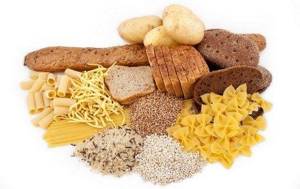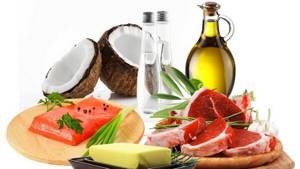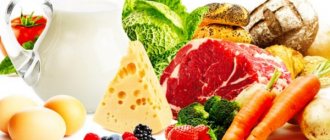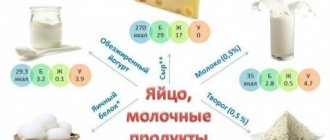What kind of carbohydrates are there?
There are three types of carbohydrates: simple (mono- and disaccharides), complex (starch), fiber (dietary fiber).
- Simple carbohydrates are so named because of their simple structure, which contains only 1-2 elements (glucose, fructose, lactose). They taste sweet and can dissolve in water. Simple carbohydrates are quickly absorbed in the intestines and sharply increase blood sugar levels, which leads to an equally sharp release of the hormone insulin by the pancreas. Main sources: sugar, honey, jam, white flour, baked goods, confectionery. Simple carbohydrates are also found in dried fruits, fruits, berries, and dairy products.
- Complex carbohydrates are so named because of their long chain of sugars, which allows them to be slowly digested and absorbed, cause a moderate rise in sugar levels, provide a feeling of fullness, and be used for energy needs rather than being stored as fat. Main sources: all cereals, except polished rice and semolina, bread and whole grain flour, legumes, baked potatoes, bread and pasta made from durum flour.
- Fiber is the coarse part of plant products - cellulose and hemicellulose, pectin, lingin, gums. Fiber slows down the absorption of sugar and fat, reduces the release of insulin in response to carbohydrate foods, improves intestinal motility and helps maintain a feeling of fullness. Main sources: non-starchy vegetables, unrefined cereals and legumes, bran, fresh fruits and berries.
Information for men
Exercises for the pectoral muscles for men at home
Plank exercise for men
Gym workout plan for men
Workout for weight loss for men at home
Healthy and unhealthy foods low in carbohydrates
Not all foods are created equal. One of the goals of a low-carb diet is to improve your overall health, so it's important to include plenty of healthy foods in your diet.
Typically these are unprocessed foods.
To improve your health through a low-carb diet, it is important to eat plenty of foods such as unprocessed meats, chicken and fish, eggs, nuts, and vegetables. Healthy fats and dairy products are also important.
Fiber is also an extremely important part of any diet. It aids digestion, reduces the impact of sugar and starchy foods on blood glucose levels and reduces the risk of heart disease, type II diabetes and diverticular disease.
Good sources of fiber in a low-carb diet include green vegetables such as spinach and chard, flax, avocados and high-fiber cereals.
Types of carbohydrates
Most carbohydrates are found in plant foods. However, many processed foods contain this substance in the form of sugar and starch.

Carbohydrates of natural origin are divided into the following types:
Fibrous
In other words, it's fiber. It belongs to complex carbohydrates. Fiber is necessary for the proper functioning of the gastrointestinal tract. In addition, it rids the digestive tract of “garbage”.
This category includes: spinach, broccoli, celery, cabbage, cucumbers, peppers, zucchini, onions. Such products do not affect the amount of insulin in the body. Therefore, this food can not be limited.
Sweet carbohydrates
Sugar is the main representative of simple carbohydrates. It is found in many foods: fruits (fructose), dairy foods (lactose), regular sugar (sucrose).
To get rid of extra pounds, it is recommended to limit the consumption of such substances. However, you should not completely abandon them.
Starchy
They belong to complex carbohydrates. Starch is found in grains and vegetables. Rich in carbohydrates: rice, potatoes, oats.
On average, it is recommended to consume about ½-1 cup of ready-made porridge. It is especially useful to take starches after physical activity, for 2-3 hours.
There is another type of carbohydrate that is not plant-based. These are processed carbohydrates. They are found in cakes, donuts, cookies, candies, and a variety of soft drinks.
Such carbohydrates must be excluded from your diet if your goal is to lose weight.
Other classification
Above is the scientific classification of carbohydrates. But they are also distinguished by their origin: natural and processed. There is also a classification according to the type of substance:
- fibrous (or fiber) - a complex carbohydrate found in foods of natural origin (onions, zucchini, peppers, cucumbers, cabbage, celery, broccoli, spinach and others);
- starch is a complex carbohydrate found in vegetables and grains (oats, potatoes, rice and others);
- sweet substances – lactose (contain dairy products); fructose (sweeteens fruits); sucrose (found in refined sugar).
Why is it necessary to count their number?
Carbohydrates are needed by the human body primarily for energy. With their deficiency, a person feels lethargic and weak. They should be present in the diet even during a diet. However, if they are in excess, there is a risk of weight gain.

Carbohydrates, if not converted into energy, can be deposited in the subcutaneous tissue, turning into unsightly folds of fat. In order for weight loss to be effective and correct, you cannot exceed the carbohydrate limit. By consuming too many carbohydrates, a person will not lose, but gain even more extra pounds. That is why it is necessary to count the amount of carbohydrates.
It must be remembered that both a lack and an excess of carbohydrates leads to negative consequences. You need to count carbohydrates very carefully when following a diet.
Why do you need proteins for weight loss?
To lose weight you need a calorie deficit, and to gain muscle and get in shape you need protein. It should be in normal quantity, within normal limits. When it comes to taking proteins, it makes no difference what time you take them. Protein should be present for breakfast, lunch, dinner, and also for a snack. If you choose a protein breakfast, you will be able to stay full longer.
There is no point in consuming protein immediately after training to lose weight and gain muscle. There should be more protein in the general daily diet. The need for protein occurs 12-48 hours after training. Therefore, there is no point in making a special protein diet after training, much less buying expensive sports nutrition for this.
Proteins when losing weight are necessary to speed up metabolism. Protein products require a lot of energy to digest. And the muscles that grow due to protein intake require more calories to maintain. These two factors speed up metabolism.
Norm of carbohydrates per day for weight loss
The average daily limit ranges from 60 to 130 g for hard low-carbohydrate foods, which gives approximately 240-520 kcal. Some diets sharply limit carbohydrates in the first phase, then increase them gradually. Others do not raise the level above 60 g per day.
Popular body wraps for weight loss and health
Which wrap is more effective for weight loss?
How to do body wraps at home for weight loss
Clay wrap for weight loss at home
The recommended amount of carbohydrates per day with proper nutrition (for maintaining or gaining weight) is 40-60% of the daily diet, which, with a total consumption of 2000 kcal, will be 800-1200 kcal or 200-300 g.
Possible dangers
Most people lose weight when they reduce their caloric intake without taking into account dietary supplements, but a low-carb menu gives better results over the same period. Most studies have shown that limiting carbohydrates throughout the year is not advisable.
A 2014 study found benefits of a low-carb diet compared to a high-protein diet, but the difference in weight was only 500 grams. Any low-carb diet reduces overall food intake and calories because protein and fat keep you full longer.
When calculating how many carbohydrates you need to eat to lose weight, it’s worth reading about the pitfalls of going carbohydrate-free. A sudden and sharp reduction in the carbohydrate component can lead to a number of symptoms:
- headaches;
- bad breath;
- fatigue and weakness;
- constipation or diarrhea.
In the long term, giving up cereals, vegetables and fruits threatens:
- vitamin and mineral deficiency;
- loss of bone mass;
- gastrointestinal diseases.
By severely cutting carbohydrates to 20 g per day, you can induce ketosis - the process of accumulation of ketones due to the breakdown of fats for energy production. Its side symptoms:
- nausea;
- headache;
- moral and physical exhaustion;
- bad breath.

How many grams of carbohydrates do you need per day to lose weight?
- The calculation algorithm is as follows: We calculate the daily caloric intake taking into account lifestyle.
- for men = 66 + (weight*13.7) + (5*height) – (6.8*age);
- for women = 655 + (weight*9.6) + (1.7*height) – (4.7*age);
- multiply by the activity coefficient: 1.2 – with a sedentary lifestyle, 1.4 – with regular walking and training, 1.7 – with hard physical labor and professional sports;
- for weight loss purposes, subtract 20% from the resulting number.
- We set protein intake from 1.5 to 2 g per kilogram of body. For kidney problems, reduce to 1 g per kg. We get approximately 120 g (480 kcal) for a woman weighing 60 kg.
- We set the fat norm from 0.5 to 0.8 g per kilogram of body. For a woman weighing 60 g – 48 g of fat or 432 kcal. For women with high cholesterol levels, reduce to 0.5 g per kilo.
- We calculate the calorie content of carbohydrates. For example, with a daily intake of 1300 kcal for a woman weighing 60 kg: 1300-480-432 = 388 kcal or 97 g.
There is no point in increasing protein levels above 2 g per kilogram of body, and if you have kidney problems, it is dangerous. You can reduce the amount of fat, but to a minimum of 30-40 g, otherwise it will harm the absorption of fat-soluble vitamins.

How many carbohydrates do you need from cereals, vegetables and fruits? Pay attention to this point if you are fighting for a sculpted body. Simple carbohydrates (fruits and sweets) should not exceed 10% of the total carbohydrate norm, the remaining 90% should be complex.
I also recommend that you allocate some of your precious time to watch this video.
Cheat sheet for a low-carbohydrate diet
There are several types of diets that differ only in the recommended daily allowance of carbohydrates. Acceptable limits are from 20 to 250 grams, but it is better to stay at 40-50. With such a daily amount of carbohydrates, you can achieve rapid weight loss without harm to the intestines and stomach.
Before creating an individual diet for a low-carbohydrate diet, it is necessary to calculate the body's calorie needs. There are different calculation schemes, but we will take the Harris-Benedict formula. To calculate the norm using it, you need to know only three values: weight (kg), age (years) and height (cm). Different indicators are given for men and women.
The daily calorie requirement (basal metabolic rate, BMR) for men is calculated as follows:
BMR = 88.36 + (13.4 x weight) + (4.8 x height) – (5.7 x age)
Example: a man in At the age of 35, she weighs 90 kg and is 178 cm tall.
BMR = 88.36 + (13.4 x 90) + (4.8 x 178) – (5.7 x 35) = 1949.5 kcal.
Formula for daily calorie needs for women:
BMR = 447.6 + (9.2 x weight) + (3.1 x height) – (4.3 x age)
Example: a woman aged 42 years weighs 73 kg and is 162 cm tall.
BMR = 447.6 + (9.2 x 73) + (3.1 x 162) – (4.3 x 42) = 1440.8 kcal.
During a diet, it is not recommended to overestimate or underestimate the daily calorie intake. Men in any circumstances need to receive at least 1900, and women - at least 1200 kcal per day.
So, to create an individual diet, it is important to know two indicators:
- The level of carbohydrates in products to comply with the norm of 40 grams.
- The number of kilocalories in foods to eat exactly as much as the body needs.
The table below shows both of these indicators for some popular foods.
Table. Calorie and carbohydrate content in foods
| Product category | Name of food product | Carbohydrate content, g | Number of kilocalories |
| Meat (100 g) | Boiled lamb | 0 | 291 |
| Boiled beef | 0 | 254 | |
| Boiled poultry and game | 0 | 170 | |
| Roast lamb | 5 | 320 | |
| Roast beef | 5 | 384 | |
| Roast poultry and game | 5 | 246 | |
| Fish and seafood (100 g) | Boiled pink salmon | 0 | 168 |
| Boiled pollock | 0 | 79 | |
| Boiled pike perch | 0 | 97 | |
| Salted herring | 0 | 145 | |
| Smoked eel | 0 | 326 | |
| Squid | 4 | 110 | |
| Shrimps | 0 | 95 | |
| Mussels | 0 | 50 | |
| Salted salmon | 0 | 296 | |
| Dairy products (100 g) | Hard cheeses | 0 | 300-400 depending on the variety |
| Cottage cheese | 1.8-2.5 depending on fat content | 79-131 depending on fat content | |
| Sour cream | 2,9-3,1 | 115-294 | |
| Milk | 4,7 | 36-61 | |
| Kefir | 4 | 30-59 | |
| Eggs (100 g) | Chicken egg | 0,7 | 157 |
| Quail egg | 0,6 | 168 | |
| Egg white | 0 | 52 | |
| Fat (20 g) | Mayonnaise | 1 | 136 |
| Butter | 1 | 143 | |
| Sunflower oil | 0 | 177 | |
| Olive oil | 0 | 177 | |
| Vegetables (100 g) | Raw carrots | 7,2 | 37 |
| Raw onions | 9,1 | 41 | |
| Raw white cabbage | 4,7 | 27 | |
| Raw cucumber | 2 | 14 | |
| Lettuce leaves | 2 | 17 | |
| Raw tomato | 4 | 23 | |
| Parsley | 8 | 49 | |
| Fried potato | 23 | 192 | |
| Stewed zucchini | 9 | 60 | |
| Boiled potatoes | 17 | 82 | |
| Boiled beets | 11 | 49 | |
| Sauerkraut | 2 | 19 | |
| Fresh fruits and berries (100 g) | Banana | 21 | 89 |
| Apple | 8 | 37 | |
| Mandarin | 8 | 40 | |
| Orange | 8 | 38 | |
| Grape | 15 | 65 | |
| Peach | 9,5 | 43 | |
| Apricot | 9 | 41 | |
| Plum | 9,6 | 43 | |
| Cherry | 10,6 | 50 | |
| Strawberry | 6,3 | 34 | |
| Currant | 7,5 | 38 | |
| Raspberries | 8,3 | 42 | |
| Nuts | Peanut | 10 | 552 |
| Almond | 13 | 609 | |
| Pistachio | 27 | 560 | |
| Walnut | 11 | 656 | |
| Brazilian nut | 12 | 656 | |
| Cashew | 22,5 | 600 | |
| Pine nut | 13 | 875 | |
| Hazelnut | 9,3 | 653 | |
| Sunflower seeds | 10,5 | 601 |

Example of a low-carbohydrate diet menu for every day
Creating a personalized diet can be time consuming. If you just want to try the diet and see if it suits you, you can use a ready-made program for a week. Here is an example of a menu for seven days for five meals a day.
Monday
Breakfast: egg omelet with bacon. Lunch: vegetable salad and a few walnuts. Lunch: boiled chicken with green peas. Afternoon snack: three egg whites and some hard cheese. Dinner: steamed fish and cottage cheese without sugar.
Tuesday
Breakfast: a glass of natural yogurt and 5-6 cashews. Lunch: green apple or orange. Lunch: soup with chicken and vegetables without potatoes or frying. Afternoon snack: vegetable salad of cucumbers, tomatoes and white cabbage. Dinner: egg white and seafood salad.
Wednesday
Breakfast: oatmeal with some nuts. Lunch: half a pomelo. Lunch: 200 g of boiled chicken with buckwheat. Afternoon snack: a glass of low-fat kefir and half a green apple. Dinner: steamed fish.
Thursday
Breakfast: egg omelet with some ham or bacon. Lunch: an apple and a glass of natural yogurt without additives. Lunch: stewed vegetables with fish. Afternoon snack: 100 g low-fat cottage cheese. Dinner: 200 g boiled chicken.
Friday
Breakfast: a little oatmeal, a glass of low-fat kefir and a handful of almonds. Lunch: 2 peaches or apricots. Lunch: lamb with broth and vegetable salad. Afternoon snack: two egg whites and a salad of cucumbers, tomatoes and herbs. Dinner: 200 g of boiled beef, cucumber salad and fresh white cabbage.
Saturday
Breakfast: buckwheat with dried fruits. Lunch: 2 green apples or oranges. Lunch: beef stew with vegetables. Afternoon snack: 2 egg whites with a salad of any fresh vegetables. Dinner: low-fat cottage cheese.
Sunday
Breakfast: oatmeal, a handful of any nuts, half an orange. Lunch: a glass of one percent kefir. Lunch: boiled chicken with vegetables. Afternoon snack: low-fat cottage cheese and half an orange. Dinner: seafood and green vegetable salad (cucumber, cabbage, green pepper, onion, parsley, dill).
Judging by the reviews, a low-carbohydrate diet is one of the few ways to lose weight and avoid constant feelings of hunger. This type of nutrition is also suitable during training; professional athletes often resort to it. However, when choosing this or that diet, remember that the most important thing is to spare your body and not follow one diet for more than three weeks.
Low carb diets
1. Low-carbohydrate diets are close to protein diets, but still differ from the latter - the rejection of carbohydrates does not occur completely, but only partially. For example, the famous Kremlin diet. The main principle of this diet is to count the carbohydrates consumed every day; no more than 40 USD per day. Table with the level of e.g. carbohydrates in each product can be found on the Internet and thereby create an acceptable diet for yourself. In unlimited quantities, this diet allows you to eat all protein foods (meat, fish, seafood, eggs, dairy products, etc.), but at the same time exclude sweets and starchy foods from the diet.
2. French diet. This diet is not only close to a carbohydrate-free diet, but is also a low-calorie type of diet. During this 2-week diet, all sweet and salty foods, as well as alcohol, are prohibited. The basis of the diet is lean meat, fish, vegetables, fruits, eggs, rye bread and herbs. Everything else is strictly prohibited and you cannot deviate from the French diet menu. Unlimited mineral water and green tea.
It is likely that for each person who is familiar with various weight loss methods first-hand, and who is constantly struggling with excess weight, the list of the most effective diets is individual in nature. After all, each person has his own structural characteristics of the body (metabolic rate, fat mass, etc.), different levels of vital activity, his own individual eating habits, etc. All these factors determine why the same diet can be extremely effective for one, but almost useless for another.
Super selection of strength exercises
How to burn fat on the stomach and sides for a man
Body Revolution with Jillian Michaels "Body Revolution"
Home workout program for girls
Jillian Michaels Beginner Shred Program

Protein products of animal origin
Animal proteins are absorbed 1.5 times better than plant proteins. Products that contain large amounts of protein are more preferable when creating a menu for weight loss.
Approximate protein content per 100 g of product:
| Product | Amount of protein per 100 g (g) |
| Red caviar | 31 |
| Other sea fish | 13-19 |
| red fish | 21-22 |
| Freshwater fish | 16-17 |
| Sea fish caviar | 28-31 |
| Crabs, shrimp, squid | 18 |
| Tuna | 23 |
| crucian carp | 18 |
| Pollock | 16 |
| Veal | 19,7 |
| Chicken breast | 23,6 |
| Chicken's meat | 18-20 |
| Turkey | 19 |
| Rabbit | 21 |
| Beef | 18-20 |
| Beef by-products (liver, kidneys, lungs) | 14-17 |
| Pork | 11-14 |
| Pork by-products | 14-19 |
| Fresh cow's milk | 3 |
| Powdered milk | 25-26 |
| Kefir, fermented baked milk, yogurt | 3 |
| Cottage cheese | 14-18 |
| Eggs | 13 |
| Cheese | 23,4 |
| Sour cream | 3 |
| Yogurt | 5 |
Basic rules of low-carb diets
Of course, exclude sweets and baked goods from your diet. Give up bread. Sugary drinks, beer and alcohol in general will also be prohibited. Don't eat pasta, starchy foods, bananas, and minimize your fruit intake.
It is recommended to eat vegetables, herbs, seeds and nuts, meat and fish in unlimited quantities. The optimal amount, which should not be increased or decreased, is 50–100 g of carbohydrates per day (or 3–5 g per 1 kg of body weight). You can't give up carbohydrates completely. Replace unhealthy carbohydrates (sugar, baked goods) with healthy ones (vegetables, apples). Carbohydrate levels should be reduced gradually. You need to drink at least 1.5–2 liters of water per day.
Plant foods containing protein
The table provides a list of plant-based protein products for weight loss. Indicators mean the approximate content of the substance in 100 g of product.
| Product | Amount of protein per 100 g (g) |
| Peas | 23 |
| Beans | 22,5 |
| Soybeans | 35 |
| Mushrooms | 3-4 |
| Sunflower seeds | 48 |
| Pumpkin seeds | 28 |
| Flax seeds | 18 |
| NUTS: | |
| Gretsky | 13 |
| Almond | 21 |
| Pistachios | 20 |
| Hazelnut | 15 |
| Cashew | 18 |
| Cabbage | 2 |
| Potato | 2 |
| Eggplant | 1 |
| Dried apricots | 5 |
| CEREALS: | |
| Wheat | 14 |
| Oats | 12 |
| Barley | 13 |
| Corn | 19,5 |
| Rice | 7 |
| Millet | 11,50 |
| Chickpeas | 20,10 |
| Hercules cereal | 11,00 |
| Potato | 2,50 |
| Dark rice | 2,58 |
| Spinach | 2,90 |
| Tofu | 17,19 |
| Buckwheat | 12,6 |
| Rice groats | 7 |
| Spinach | 4 |
| Avocado | 4 |
| Broccoli | 3 |
| Green pea | 5 |
| Soy milk | 3 |
| Banana | 1,5 |
The Science of Weight Loss
A low-carb diet is one of the weight loss plans available to implement. But twenty documented studies show that you can't limit carbohydrates without increasing protein levels. Therefore, the question remains about the effect of high-protein foods on the fat burning process.
Converse research suggests that when protein intake is adequate, a low-carbohydrate diet does not provide much of a benefit. Of course, it will work for people who are overweight and have poor carbohydrate absorption due to insulin resistance.
A study by researchers at Tufts-New England Medical Center found that a low-glycemic diet helped reduce weight in people with high insulin secretion, but not in adults with normal insulin secretion.
A study at the University of Colorado found that obese women who were insulin sensitive lost more weight on high-carbohydrate, low-fat diets than the other way around. The difference was 13.5% and 6.8% of body weight. Insulin resistance really makes a low-carb diet worthwhile.












